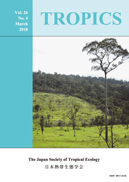
- Issue 4 Pages 99-
- Issue 3 Pages 71-
- Issue 2 Pages 37-
- Issue 1 Pages 1-
- |<
- <
- 1
- >
- >|
-
Ei Thandar Bol, Naoko Tokuchi2018Volume 26Issue 4 Pages 99-109
Published: 2018
Released on J-STAGE: March 01, 2018
JOURNAL FREE ACCESSCommunities in Myanmar rely heavily on forests for various uses, but there have been few studies on disturbance to tropical evergreen forests in the country. There is a growing need to evaluate the responses after disturbances relating to soil condition to inform sustainable forest management practices to all regulating agencies. This study assessed the impact of forest disturbances on soil properties in a tropical evergreen forest ecosystem in Myanmar. Soil samples were collected from the sites with three different types of forest disturbance, namely 1) shifting cultivation (≥15 years post-abandonment), 2) landslide (20 years post-landslide), 3) selective logging (>30 years post-logging), and 4) old growth forest (no recorded history of disturbance over the last 80 years), to determine the effects of forest disturbances on soil carbon (C), nitrogen (N), available phosphorus (AP), pH, and bulk density (BD). Soil C, N, and AP concentrations were significantly higher in old growth forest soils than in the other disturbed forests, while BD was lowest in old growth forest soils. There were no significant differences in soil properties between soil depths, except in BD. Selective logging area soils had the lowest C, N, and pH values, and AP may be severely depleted in areas of shifting cultivation. Our results confirm that forest disturbances can alter soil properties and that the impacts differ among forest disturbance types. Forest areas were slashed and burned for cultivation, cleared by landslides, and selectively logged during harvesting time, and after abandonment, the soil conditions determined the recovery pattern of the forest. According to our results, a logging cycle of more than 30 years is essential to mitigate the influences of logging on soil nutrients.
View full abstractDownload PDF (753K)
-
Ryo Kitamura, Naoki Okada, Masaharu Sakai, Thiti Visaratana, Ratana Th ...2018Volume 26Issue 4 Pages 111-121
Published: 2018
Released on J-STAGE: March 02, 2018
JOURNAL FREE ACCESSWe examined the ‘catalyzing effect’, by which the establishment of indigenous species and secondary succession are facilitated in plantations. A tree census was conducted at two 24-year-old plantations (agroforestry and eucalyptus plots), and a grassland in northeast Thailand. Three natural forests adjacent to the two plantation plots and the grassland plot were also investigated to evaluate their possible influence on the catalyzing effect based on the differences in species diversity and the intensity of disturbance among the natural forests. The catalyzing effect seemed to be observed at the study site; the two plantations had more individuals and species of indigenous trees than the grassland, indicating faster natural regeneration of the formers than the latter. Although our results found the tendency of the catalyzing effect, further studies using sufficient plot replication are required to verify the generality of the effect.
View full abstractDownload PDF (927K)
- |<
- <
- 1
- >
- >|